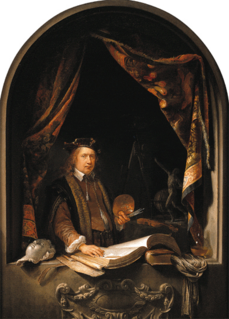
Gerrit Dou, also known as GerardDouw or Dow, was a Dutch Golden Age painter, whose small, highly polished paintings are typical of the Leiden fijnschilders. He specialised in genre scenes and is noted for his trompe-l'œil "niche" paintings and candlelit night-scenes with strong chiaroscuro. He was a student of Rembrandt.

Dirck Jansz Pesser was a Dutch brewer from Rotterdam, best known today for his portrait by Rembrandt. He was an important member of the Rotterdam Remonstrant community in the early 17th century.

Pieter Cornelisz van Slingelandt was a Dutch Golden Age portrait painter who had been a pupil of Gerard Dou and is known as one of Leiden's fijnschilders..

Portrait of Anna van der Aar is an oil-on-panel painting by the Dutch Golden Age painter Frans Hals, painted in 1626 and now in the Metropolitan Museum of Art, in New York. It is considered a pendant portrait to that of her husband, the writer Petrus Scriverius.
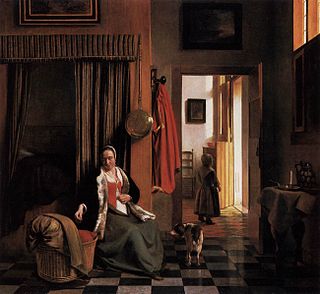
Woman lacing her bodice beside a cradle is an oil-on-canvas painting by the Dutch painter Pieter de Hooch, created c. 1660–1663. It is part of the collection of the Gemäldegalerie, Berlin.

Mother with a Child and a Chambermaid (1665–1668) is an oil-on-canvas painting by the Dutch painter Pieter de Hooch. It is an example of Dutch Golden Age painting and is part of the collection of the Amsterdam Museum.

Merry Company with Two Men and Two Women, also known as The Visit, is an oil-on-panel painting by the Dutch painter Pieter de Hooch, created c. 1657. It is an example of a Merry Company, a popular form of genre painting in Dutch Golden Age painting showing a group of figures, who are not meant to be identified as portraits, enjoying each other's company. It is now in the Metropolitan Museum of Art, in New York.

Interior with a Young Couple and a Dog (1662) is an oil-on-panel painting by the Dutch painter Pieter de Hooch; it is an example of Dutch Golden Age painting and is now in the Metropolitan Museum of Art.

Teaching a Child to Walk is an oil-on-canvas painting by the Dutch painter Pieter de Hooch. It is an example of Dutch Golden Age painting and is part of the collection of the Museum der bildenden Künste.

The Ray of Light, also known as Le Coup de Soleil, is an oil on canvas painting by the Dutch painter Jacob van Ruisdael. It is an example of Dutch Golden Age painting and is now in the collection of the Louvre Museum.
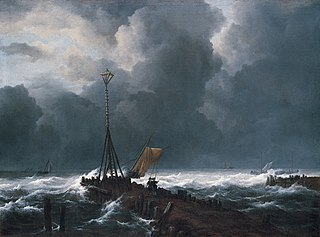
Rough Sea at a Jetty is an oil on canvas painting by the Dutch landscape painter Jacob van Ruisdael. It is an example of Dutch Golden Age painting and is now in the collection of the Kimbell Art Museum.
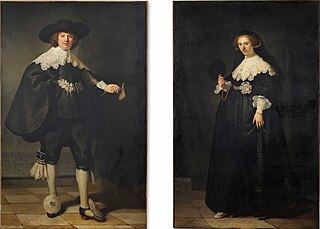
The pendant portraits of Marten Soolmans and Oopjen Coppit are a pair of full-length wedding portraits by Rembrandt. They were painted on the occasion of the marriage of Marten Soolmans and Oopjen Coppit in 1634. Formerly owned by the Rothschild family, they became jointly owned by the Louvre Museum and the Rijksmuseum in 2015 after both museums managed to contribute half of the purchase price of €160 million, a record for works by Rembrandt.
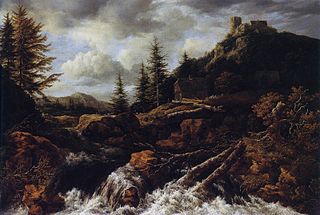
Waterfall in a Mountainous Landscape with a Ruined Castle is an oil on canvas painting by the Dutch landscape painter Jacob van Ruisdael. It is an example of Dutch Golden Age painting and is now in the collection of the Mount Stuart House.

The Kitchen Maid (1651) is an oil-on-canvas painting by the Dutch painter Rembrandt. It is an example of Dutch Golden Age painting and is now in the collection of the Nationalmuseum, Stockholm, Sweden.

Lucretia is a 1664 history painting historically attributed to the Dutch Golden Age painter Rembrandt in the collection of the National Gallery of Art. In 2015, Ernst van de Wetering of the Rembrandt Research Project said that "the formal properties and execution of [this] painting, I am convinced, exclude the possibility that it could be an autograph work by Rembrandt", and that the painting recalls Aert de Gelder. The painting is not included in the project's 2015 Rembrandt corpus.

Young Lady Playing a Clavichord is a 1660s genre painting by Gerrit Dou. It is an example of Dutch Golden Age painting and is today in a private collection.

Portrait of Gerard de Lairesse is a 1665–1667 oil-on-canvas painting by Rembrandt. It shows the painter Gerard de Lairesse holding a paper. It is in the collection of the Metropolitan Museum of Art.

Portrait of an Old Woman is a c. 1640 portrait painting painted in the style of Jacob Adriaensz. Backer. It shows an old woman with folded hands. It is in the collection of the Metropolitan Museum of Art.
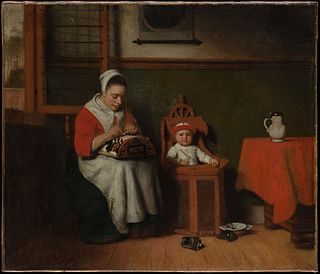
The Lacemaker is an oil on canvas painting by the Dutch painter Nicolaes Maes, created c. 1656. It is an example of Dutch Golden Age painting and is part of the collection of the Metropolitan Museum of Art, in New York.

Children Playing with a Goat is an 18th-century grisaille painting in the style of Jacob de Wit, known as a "witje". It shows a relief of children playing with a goat after a relief by Francois Duquesnoy. It is in the collection of the Metropolitan Museum of Art.





























